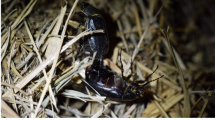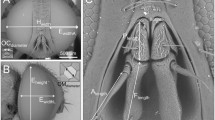Abstract
The flight ability was compared between a host-alternating and multivoltine gall midge, Asphondylia yushimai Yukawa and Uechi (Diptera: Cecidomyiidae) and a monophagous and univoltine congener, A. aucubae Yukawa and Ohsaki (Diptera: Cecidomyiidae) using devices with a CCD camera and an apparatus for analyzing tethered flight sounds. The total flying time of their females was more than 2 h on average. The maximum continuous flying time was nearly 10 h in A. yushimai and 5 h in A. aucubae. The speed of wing-beat stroke was higher in males than in females in the two species, being adapted to mobile flight for swarming of the males, while the lower speed of stroke enables the females to fly long distance. In particular, the larger wing size of A. yushimai females was considered to support their gentle flight for long-distance. The flying speed of A. yushimai was 22.9 m/min. The flying speed and the maximum continuous flying times indicate that the A. yushimai females carry the potential strong flight ability, i.e. continuously 13.7 km within 10 h. Besides phototaxis, A. yushimai females flew to an upward direction, indicating that they fly up to the sky after mating, which was confirmed by finding a pupa in a soybean pod gall on the 19 m high rooftop of a building. The current results were reflected well in the different life history traits between A. yushimai and A. aucubae. The long-distance flight ability of A. yushimai supports the possibility of its annual northward dispersal in northern Honshu, Japan.





Similar content being viewed by others
References
Bissett J, Borkent A (1988) Ambrosia galls: the significance of the fungal nutrition in the evolution of the Cecidomyiidae (Diptera). In: Pirozynski KA, Hawksworth DL (eds) Coevolution of fungi with plants and animals. Academic Press, New York, pp 203–225
Blondeau J (1981) Aerodynamic capabilities of flies, as revealed by a new technique. J Exp Biol 92:155–163
Brodsky AK (1994) The evolution of insect flight. Oxford University Press, Oxford
Cloudsley-Thompson L (1955) The design of entomological aktograph apparatus. Entomologist 88:153–161
Cloudsley-Thompson JL (1961) Rhythmic activity in animal physiology and behavior. Academic Press, New York
Docters van Leeuwen WM (1922) The galls of the islands of the Krakatau-group and of the island of Sebesy. Bull Jardin Bot Buitenzorg III 46(47):288–314
Fyodorova MV, Lapshin DN (1990) Responses of moths to ultrasound. In: Gribakin FG, Wiese K, Popov AV (eds) Sensory systems and communication in Arthropods. Birkhauser Verlag, Basel, pp 178–181
Gagné RJ (1989) The plant-feeding gall midges of North America. Cornel University Press, Ithaca
Hsiao HS (1972) The attraction of moths (Trichoplusia ni) to infrared radiation. J Ins Physiol 18:1705–1714
Kakiya N, Kiritani K (1972) The influence of maternal age, and rearing density upon flight activity of the green rice leafhopper, Nephotettix cincticeps (Hemiptera: Deltocephalidae). Jpn J Appl Entomol Zool 16:79–86 (In Japanese with English summary)
Kanmiya K (1994) Flight analysis system using strain-gauge transducers to estimate power and pattern of flying insects. Jpn J Appl Entomol Zool 38:261–273 (In Japanese with English abstract)
Kanmiya K, Nakagawa K, Tanaka A, Kamiwada H (1987) Comparison of acoustic properties of tethered flight sounds for wild, mass-reared, and irradiated melon flies, Dacus cucurbitae Coquillett (Diptera: Tephritidae). Appl Entomol Zool 22:85–97
Kobune S, Kajimura H, Masuya H, Kubono T (2012) Symbiotic fungal flora in leaf galls induced by Illiciomyia yukawai (Diptera: Cecidomyiidae) and in its mycangia. Microbial Ecol 63:619–627
Kranzler GA, Earp UF (1972) Response of the cabbage looper moth to ultrasound. Trans ASAE 15(492–493):497
Miller TA (1979) Insect neurophysiological techniques. Springer-Verlag, New York
Ohkubo N (1973) Experimental studies on the flight of planthoppers by the tethered flight technique. I Characteristics of flight of the brown planthopper Nilaparvata lugens Stål and effects of some physical factors. Jpn J Appl Entomol Zool 17:10–18 (In Japanese with English summary)
Ohsaki N, Yukawa J (1990) Gradual increase in the number of Asphondylia aucubae (Diptera, Cecidomyiidae) due to inversely density-dependent mortality processes. Ecol Res 5:173–183
Ohtani T, Yazawa Y, Yukawa J (1983) Developmental zero point of the ligustrum fruit midge, Asphondylia sphaera Monzen and the aucuba fruit midge, Asphondylia sp. (Diptera: Cecidomyiidae). Proc Assoc Pl Prot Kyushu 29:118–121 (In Japanese with English summary)
Partomihardjo T, Yukawa J, Uechi N, Abe J (2011) Arthropod galls found on the Krakatau Islands and in adjacent areas of Indonesia, with reference to faunistic disharmony between the islands and the whole of Indonesia. ESAKIA 50:9–21
Perumpral JV, Earp UF, Stanley JM (1972) Strain gage transducer to study the response of insects to physical stimuli. Trans ASAE 15:785–787
Pringle JWS (1957) Insect flight. Cambridge University Press, Cambridge
Ribak G, Barkan S, Soroker V (2017) The aerodynamics of flight in an insect flight-mill. PLoS One. https://doi.org/10.1371/jounal.pone.0186441
Rygg TD (1966) Flight of Oscinella frit L. (Diptera: Chloropidae) female in relation to age and ovary development. Entomol Exp Appl 9:74–84
Snow WF (1980) Field estimates of the flight speed of some West African mosquitoes. Ann Trop Med Parasitol 74:239–242
Tamura I (1952) Ecological studies on the insect injury of soy bean plant. Bunkyôsha, Tokyo (In Japanese with English summary)
Tokuda M (2012) Biology of Asphondyliini (Diptera: Cecidomyiidae). Entomol Sci 15:361–383
Tokuda M, Matsuo K, Yukawa J (2012) Insect galls found on Miyakejima and Hachijojima, the Izu Islands, Tokyo, Japan. ESAKIA 52:59–66
Tokuda M, Matsuo K, Kiritani K, Yukawa J (2013) Insect galls found on Ohshima, Kozushima and Niijima Islands, the Izu Islands, Tokyo, Japan. Acta Dipterol 25:1–16
Uechi N, Yukawa J (2006) Life history patterns and host ranges of the genus Asphondylia (Diptera: Cecidomyiidae). In: Ozaki K, Yukawa J, Ohgushi T, Price PW (eds) Galling arthropods and their associates: ecology and evolution. Springer-Verlag, Tokyo, pp 275–285
Uechi N, Yukawa J, Usuba S (2005) Discovery of an additional winter host of the soybean pod gall midge, Asphondylia yushimai (Diptera: Cecidomyiidae) in Japan. Appl Entomol Zool 40:597–607
Uechi N, Kim W, Tokuda M, Fujii T, Kikuchi H, Kakizaki M, Iwasaki A, Paik JC, Yukawa J (2018) Genetic and ecological differences between Asphondylia yushimai and the ivy gall midge, Asphondylia sp. (Diptera: Cecidomyiidae) with a new distribution record of the former from Hokkaido and South Korea. Appl Entomol Zool 53:363–371
Yoshitake H, Masaoka K, Sato S, Nakashima A, Kamitani S, Yukawa J, Kojima H (2001) Occurrence of Rhynchophorus ferrugineus (Coleoptera: Dryophthoridae) on Nokonoshima Island, southern Japan and its possible invasion further north. Proc Assoc Pl Prot Kyushu 47:150–154 (In Japanese with English summary)
Yukawa J (1971) A revision of the Japanese gall midges (Diptera: Cecidomyiidae). Mem Fac Agric Kagoshima Univ 8:1–203
Yukawa J, Miyamoto K (1979) Redescription of Asphondylia sphaera Monzen (Diptera, Cecidomyiidae), with notes on its bionomics. Mem Fac Agric Kagoshima Univ 15:99–106
Yukawa J, Ohsaki N (1988a) Separation of the aucuba fruit midge, Asphondylia aucubae sp. nov. from the ampelopsis fruit midge, Asphondylia baca Monzen (Diptera: Cecidomyiidae). Kontyû 56:365–376
Yukawa J, Ohsaki N (1988b) Adult behaviour of the aucuba fruit midge, Asphondylia aucubae Yukawa & Ohsaki (Diptera: Cecidomyiidae). Kontyû 56:645–652
Yukawa J, Ohtani T, Yazawa Y (1983) Host-change experiments from wild plants to soybean in Asphondylia species (Diptera: Cecidomyiidae). Proc Assoc Pl Prot Kyushu 29:115–117 (In Japanese with English summary)
Yukawa J, Uechi N, Horikiri M, Tuda M (2003) Description of the soybean pod gall midge, Asphondylia yushimai sp. n. (Diptera: Cecidomyiidae), a major pest of soybean and findings of host alternation. Bull Entomol Res 93:73–86
Yukawa J, Ichinose M, Kim W, Uechi N, Gyotoku N, Fujii T (2016) Lower development threshold temperatures and thermal constants for four species of Asphondylia (Diptera: Cecidomyiidae) in Japan and their larval developmental delay caused by heat stress. Appl Entomol Zool 51:71–80
Acknowledgements
We express our thanks to Dr. K. Kiritani (Emeritus Researcher, NARO Institute for Agro-environmental Sciences, Japan) and Dr. N. Uechi (Institute of Fruit Tree and Tea Science, NARO Institute for Agro-environmental Sciences, Japan) for their comments on an early draft. We are indebted to Dr. T. Kidokoro (Former Researcher, Miyagi Prefectural Institute of Agriculture and Horticulture, Japan) who collected soybean pod galls from Miyagi Prefecture, from which we reared adults of A. yushimai for the flying test. Our thanks are extended also to Mr. S. Hosoyamada (Terayama Station for Education and Research on Nature, Faculty of Education, Kagoshima University, Japan, retired) for his arrangements in the field surveys and to Mr. H. Kikuchi (Akita Prefectural Agricultural Experiment Station, Akita, Japan) for providing us with the photograph of an adult of A. yushimai.
Author information
Authors and Affiliations
Corresponding author
Additional information
Publisher's Note
Springer Nature remains neutral with regard to jurisdictional claims in published maps and institutional affiliations.
Rights and permissions
About this article
Cite this article
Yukawa, J., Moriya, T. & Kanmiya, K. Comparison in the flight ability between the soybean pod gall midge, Asphondylia yushimai and the aucuba fruit gall midge, A. aucubae (Diptera: Cecidomyiidae). Appl Entomol Zool 54, 167–174 (2019). https://doi.org/10.1007/s13355-019-00609-1
Received:
Accepted:
Published:
Issue Date:
DOI: https://doi.org/10.1007/s13355-019-00609-1




